Scottish agricultural survey: December 2018
Annual agricultural survey results based on data from larger agricultural holdings together with estimates for smaller farms.
This document is part of a collection
December 2018 Scottish Agricultural Survey
Introduction
Winter-planted crops increased over the past year. Just under 197,000 hectares were planted in 2018, the highest area since 2014.
Dry weather resulted in slight drops grass silage/haylage production.
Cattle and pig numbers continued to decline, however there were slight increases in the number of poultry with sheep numbers remaining steady.
Agricultural rents rose to an average £40 per hectare.
Commonly used terms
Hectares (ha): the official measurement of agricultural land. One hectare is 10,000m2 or roughly the same size as a full-size rugby pitch.
Ten-year average: This publication compares current values to the average value over the past ten years. This provides a valuable comparison to previous years and helps set the latest figures in a wider context.
Winter-planted crops increase due to weather
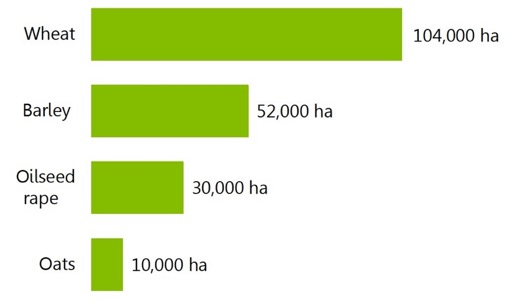
Crops planted in the autumn and grown over the winter period are known as winter planted crops. The area planted is heavily dependent on the weather, with the remaining area then generally planted in the spring.
Area used to grow winter crops 197,000 hectares
Improved weather conditions led to an increase in the total amount of winter-planted crops in Scotland compared to the previous year and slightly above the ten year average. There were 197,000 hectares of land used to grow winter crops, two percent higher than the ten-year average of 192,000 hectares. This was a 13 per cent increase from 174,000 hectares last year.
Wheat, Scotland’s biggest winter-planted crop, rose by 12 per cent, to 104,000 hectares, four percent higher than the ten-year average.
The area used to grow winter oats increased to a ten-year high. There was 10,000 hectares of land used to grow winter oats in 2018, a rise of 20 per cent on the 8,500 hectares the previous year.
Dry summer impacts animal feed production
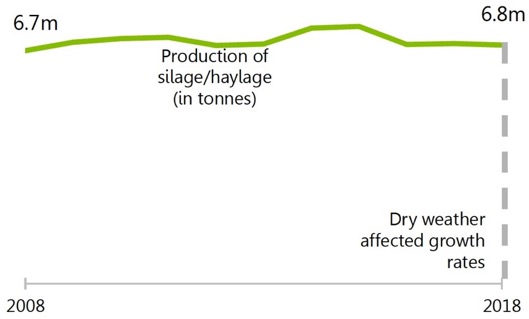
Grass cut in the summer, which is fermented and has a high moisture content, and is used as animal feed in the winter is called grass silage. Summer cut grass, which has low moisture content and is mostly used to feed horses is called haylage. Hay is grass which has been cut and dried to be stored as animal feed.
Production of grass silage or haylage 6.8 million tonnes
Dry summer weather resulted in an increase in hay production, but a slight drop in silage/haylage production. Overall production fell slightly by one per cent to 6.8 million tonnes over the past year. There was a 17 per cent increase in the area of grass sown. This drop has led to some farmers reporting a shortage of animal feed and increasing costs. Production in 2018 was slightly lower than the ten-year average. Hay and arable silage both saw increases in production over the past year. There was a large increase in the area of land cut for hay.
Cattle numbers continue long term decline
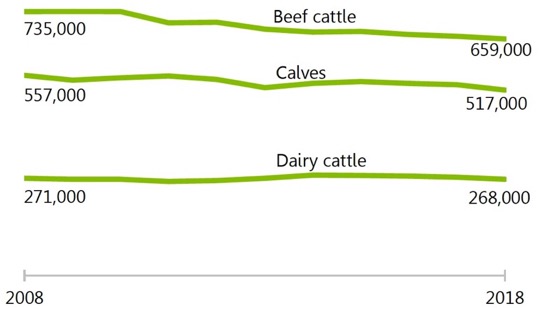
By law all cattle in Scotland must be registered onto the UK Government’s ‘Cattle Tracing System’. Each animal has a unique tracking number shown on an ear tag. The cattle numbers shown in this publication are taken from the Cattle Tracing System.
Number of cattle in Scotland in December 2018 1.66 million
Cattle numbers in Scotland continue to fall. In December 2018, there were 1.66 million cattle in Scotland. This is five percent lower than the ten-year average and a drop of two per cent on 1.69 million from the previous year.
The number of cattle has fallen in both the beef and dairy sectors over the past year. Beef fell by one per cent and dairy by two per cent. There was also a three per cent drop in the number of calves.
Poor weather may have impacted cattle numbers over the past year. The long period of warm weather reduced the amount of grass grown for feed.
The shortage of feed during the warm summer has led to higher costs. Farmers may have slaughtered cattle earlier or in higher numbers to save on costs.
Sheep numbers remain stable
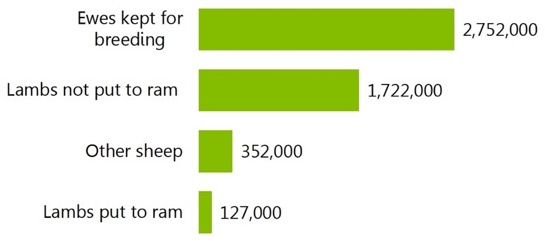
Sheep have lambs once per year, during springtime. The number of lambs on farms falls from spring to winter time as lambs are sold for slaughter. This means that lamb numbers are lower than reported in the June Agricultural Census.
Number of sheep in Scotland as at December 2018 4.95 million
Sheep numbers have remained steady despite challenging conditions. In December 2018, there were 4.95 million sheep in Scotland, an increase of one per cent on 2017. The total sheep numbers are one percent lower than the ten-year average.
Poor weather at lambing followed by a dry summer may have resulted in a delay in getting lambs up to weight for slaughter. The delay means a higher number of lambs are still on farm at the start of December.
Number of poultry in Scotland in December 2018: 14.7 million
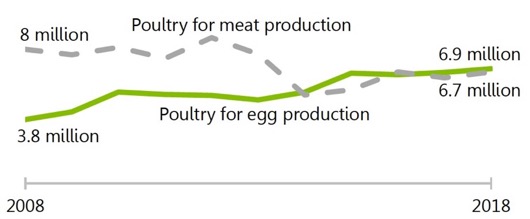
Poultry numbers increased over the past year. In December 2018, there were an estimated 14.7 million poultry birds in Scotland, a rise of three per cent over the past year.
Despite an increase in the number of poultry birds for meat production (six per cent over the past year) the number of egg-laying birds outnumbered them for the second consecutive year.
Number of pigs in Scotland in December 2018: 333,000
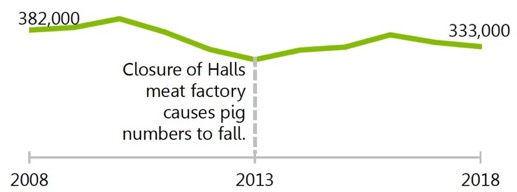
Agricultural rents increase over past year
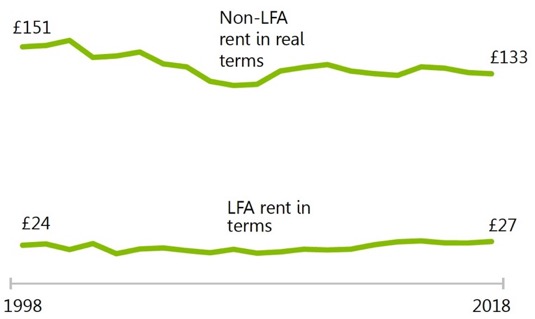
“Less Favoured Area” (LFA) is land which has a natural disadvantage that makes agricultural production difficult. Over 5.73 million hectares of Scottish farmland (85%) is LFA land.
A “real terms” value is a value that has been adjusted for inflation. Inflation is the rate of increase in prices for goods and services from one year to the next.
Average (mean) rent paid for agricultural land £40 per ha
Average rent increased slightly to £40 per hectare. Better quality land has a higher rent and the average for non-LFA agricultural land was £133 per hectare in 2018. This is a one per cent fall from 2017. Rents for poorer quality LFA land increased by four per cent over the past year, rising from £26 per hectare to £27.
Real terms rents in Scotland have fallen by 12 per cent, from £151 per hectare to £133 per hectare, for non-LFA farms since 1998. Over the same time period rents for LFA land have increased by 13 per cent from £24 per hectare to £27.
Farm types which can operate on LFA land, such as cattle and sheep farms, generally have smaller rents. Cereal farms which require good quality land generally have larger rents.
East of Scotland has the highest agricultural rents
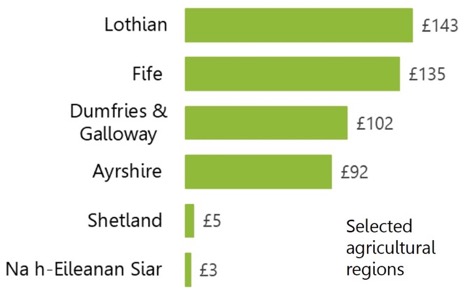
The median is a different type of average that identifies where half the rents are higher and half the rents are lower. It is a better measure of the average rental value than the mean as a measure of average which would appear higher because of farms with very large rents.
Median rents in Lothian £143 per ha
Median rents vary across the country. Rents in the North East and South East are generally higher. Lothian and Fife have the highest rents in Scotland due to their high quality land and central location.
Na h-Eileanan Siar and Shetland have the lowest rents, due to the poor quality land and remote location.
Ayrshire and Dumfries & Galloway have relatively higher rents considering the amount of less-favoured area land. These areas hold most of Scotland’s dairy herd which may be driving higher rents.
Machinery levels fall on Scottish farms
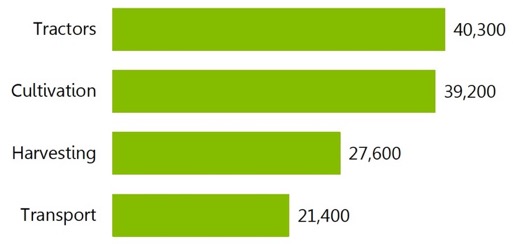
Information on machinery is only collected for larger farms. We collect data on categories of tractors by brake horse-power (bhp) ranging from under 35 bhp to 201 bhp or over.
Tractors 40,300
The number of tractors and machines on Scottish farms fell in the past year. The number of tractors fell by four per cent over the past year to 40,300 while the number of transport vehicles fell by one per cent to 21,400.
In recent years it is likely that an increase in the use of contract farming has led to a decrease in the number of machines on farms, as a growing number of farms hire machinery and workers instead of purchasing their own.
Data sources and more information
Data source
This data is collected via an annual December Survey run by the Rural and Environmental Science & Analytical Services Division of the Scottish Government. The December Survey collects various data from agricultural holdings across Scotland. Sheep data are also collected during the annual sheep and goat inventory.
A full quality assurance and methodology report can be found accompanying this report.
www.gov.scot/stats/bulletins/01330
Contact : Scott McFarlane
Contact Email: agric.stats@gov.scot
Data tables
A full set of data tables for this publication is available online in the accompanying spreadsheet.
www.gov.scot/stats/bulletins/01330
Crown Copyright
You may use or re-use this information (not including logos) free of charge in any format or medium, under the terms of the Open Government Licence. See: www.nationalarchives.gov.uk/doc/open-government-licence/
Comparisons
Similar surveys take place each year in England, Wales and Northern Ireland. Full results for the United Kingdom are available via the link below:
https://www.gov.uk/government/collections/agriculture-in-the-united-kingdom
Contact
Email: Scott.McFarlane@gov.scot
There is a problem
Thanks for your feedback